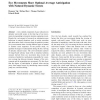Free Online Productivity Tools
i2Speak
i2Symbol
i2OCR
iTex2Img
iWeb2Print
iWeb2Shot
i2Type
iPdf2Split
iPdf2Merge
i2Bopomofo
i2Arabic
i2Style
i2Image
i2PDF
iLatex2Rtf
Sci2ools
COGCOM
2011
2011
Eye Movements Show Optimal Average Anticipation with Natural Dynamic Scenes
A less studied component of gaze allocation in dynamic real-world scenes is the time lag of eye movements in responding to dynamic attention-capturing events. Despite the vast amount of research on anticipatory gaze behaviour in natural situations, such as action execution and observation, little is known about the predictive nature of eye movements when viewing different types of natural or realistic scene sequences. In the present study, we quantify the degree of anticipation during the free viewing of dynamic natural scenes. The cross-correlation analysis of image-based saliency maps with an empirical saliency measure derived from eye movement data reveals the existence of predictive mechanisms responsible for a nearzero average lag between dynamic changes of the environment and the responding eye movements. We also show that the degree of anticipation is reduced when moving away from natural scenes by introducing camera motion, jump cuts, and ’¼ülm-editing. Keywords Eye movements ├...
| Added | 13 May 2011 |
| Updated | 13 May 2011 |
| Type | Journal |
| Year | 2011 |
| Where | COGCOM |
| Authors | Eleonora Vig, Michael Dorr, Thomas Martinetz, Erhardt Barth |
Comments (0)

